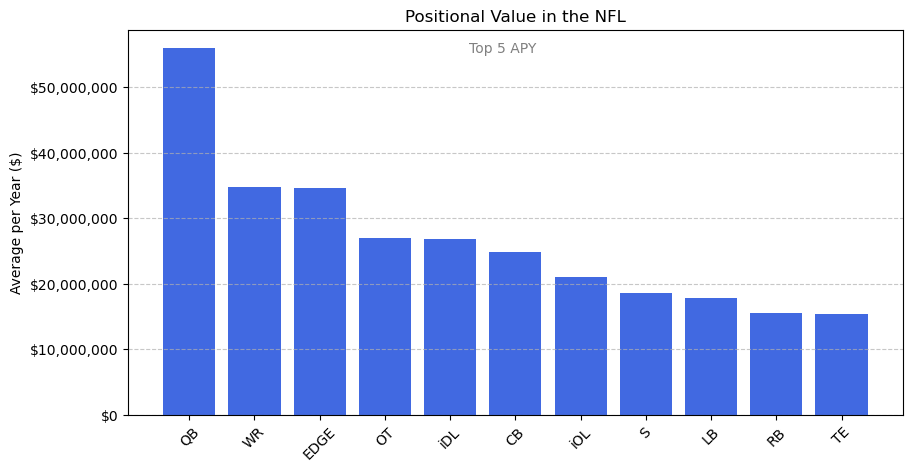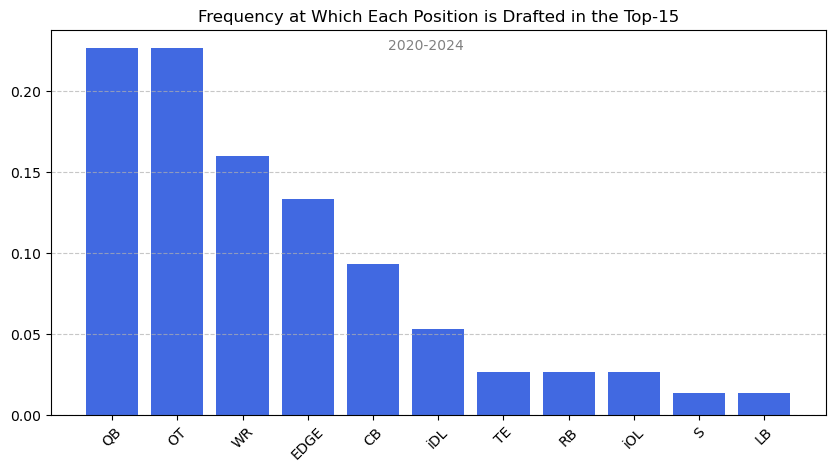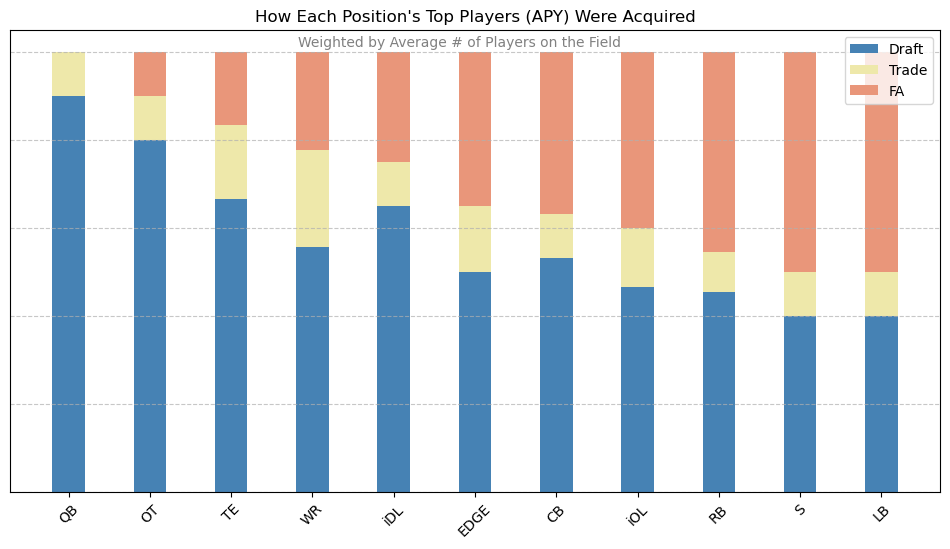Cracking the NFL Offseason
By Alex Laughlin | May 22, 2025

In the NFL, games are won on the football field. But, champions are built in the offseason. Even though no games are played, the offseason is the most important time of the year for NFL franchises; good teams retool their rosters to maintain their lead on the pack, while middling teams take swings to close the gap and bad teams rebuild. With two main modes of team improvement at their disposal (free agency and the draft), NFL teams are forced to make decisions: what kinds of players do they want, and where should they get them?
The goal of an offseason is to obtain and retain great players. A given player’s skill isn’t the only factor that matters to teams, though; they also have to take into consideration positional value. In the NFL, some positions are more impactful than others, and this imbalance is reflected in the differences in pay between positions.

By looking at the positions that NFL teams are willing to pay the most money to, we’re given insight into how important the league thinks having star players at each position is to winning a Super Bowl. This makes our mock offseason a little easier, now: we know what kinds of players we want to target, but how can we acquire them?
An important concept that needs introduction before we move on is the idea of surplus value. Surplus value is the difference between a player’s performance and the cost of their contract. Given that we have a salary cap, we need to maximize this value in order to get the most production out of our players for the least amount of money, allowing us to pay as many good players as possible. The most effective way to maximize our surplus value is through rookie contracts, which guarantee us four years of play at a much cheaper cost than market value; if we hit on a draft pick, we’re guaranteed to be operating at a profit.
Because of the importance of surplus value, we want to prioritize valuable positions in the draft, as they’re more likely to save us money. We need to be careful, though, as we can make decisions that give positive surplus value that are still mistakes. For example, if we have the option between taking a quarterback and a wide receiver, and we think both players are elite, taking the receiver would be a blunder. This is because if both players play themselves to the top of their respective positions (as elite players in this scenario), the two players will be paid the same amount of money, but the quarterback will be playing at a $55 million level while the receiver is only playing at a $35 million dollar level. We gained surplus value by drafting the receiver, but we missed out on a lot more by passing on the quarterback.

Naturally, the most expensive positions are taken early and often in the draft, having the most potential surplus value. Not everything lines up exactly as expected, though; most notably, we observe that offensive tackles are drafted at a remarkably high rate given our earlier observations about their positional value. Here, the NFL is directly contradicting what it told us earlier. Why?
The overdrafting of offensive tackles early in the first round is a simple case of supply and demand. Firstly, offensive tackles have an extremely high demand – offensive line play as a collective can make or break a team’s season, and there are a lot more bad offensive lines than good ones. At the same time, there are not very many great offensive tackles in the world: it’s a really difficult job, even by superhuman athlete standards. This low supply of offensive tackles drives the demand even further up, leading to the trend we’re observing. NFL teams are desperate for good tackle play, leading them to draft them earlier/reach for them, which then makes them even more scarce, forcing teams to draft them even earlier which creates a positive feedback loop. This phenomenon often forces the teams picking later in the draft to build their offensive lines through other means, leading to mixed results (hi, Kansas City!).
We also notice that interior defensive line players are seemingly underdrafted relative to their value. This is because the position, by nature, is top-heavy. The best interior defensive linemen can wreck games similarly to the way elite edge rushers can, but outside of that top group, it’s a lot of players that are very similar in play style and impact.
Now, we have a good idea of which positions we should target to build our team. But how should we balance free agency and the draft?

Here, I’ve displayed each position by how likely we are to be able to acquire one of its most accomplished players in free agency. I’ve adjusted the amount of players for each position’s sample based on how many players are on the field (e.g. 3 iOL to 1 QB, so we’re looking at the top 30 iOL and top 10 QBs) in order to try to minimize the over/underrepresentation of certain positions. This visualization gives us insight into how we need to plan our offseason to fill holes at certain positions; if we need a franchise-defining player like a quarterback, for example, we’re going to have to invest significant draft capital to obtain their talents. But, if we’re looking for complementary pieces, free agency is likely to include a premier player at the position we’re interested in.
An interesting trend revealed by the data is how the top tight ends in the league are much harder to find in free agency than we would expect given their positional value. This is an interesting case where tight ends have deflated contract sizes relative to their impact, so the best ones are easy to bring back, reaching free agency less often.
Also noteworthy is the availability of top edge rushers in free agency. All of our other data suggests that EDGE is an upper-echelon position in terms of impact, but for some reason, NFL teams are willing to let their best rushers walk at a higher rate than we would expect. I suspect that this is a case in which front offices still have optimization to do – if these edge rushers really are as valuable as they’re being treated, they shouldn’t be so readily available. If we can capitalize by signing a prolific edge rusher in free agency, we gain a major contributor without having to spend precious draft capital, giving us more optionality when the draft comes around.
Overall, a given team’s goals depend on the state of the franchise. When a team is evaluating its needs at individual positions, though, they should always be taking a question into consideration: can we get away with filling this hole in free agency? If they can, they should – contenders are made up of elite players at valuable positions, and elite players at valuable positions are found in the draft. Every year, every team has access to all of the same players in free agency. The draft is much less forgiving; if you pass on a player at a valuable position one year, you run the risk of getting locked out of drafting value at that position for years in the future. Champions are built by taking advantage of rare opportunities – and undone by letting them slip away.

